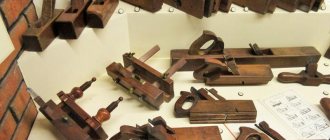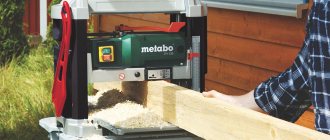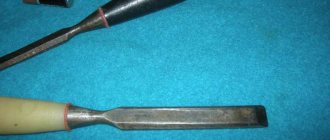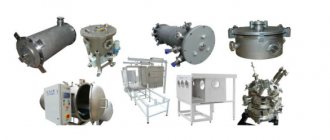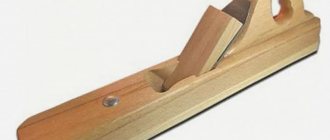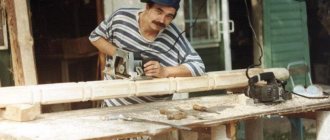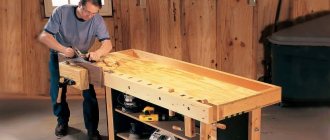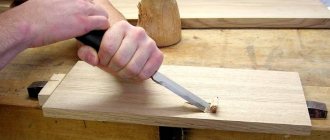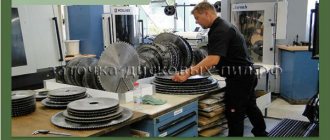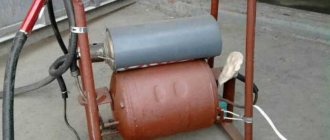Hand plane is a planing tool that is used in construction, workshops and everyday life. It consists of a body with a handle, and a blade is fixed in its sole. As the tool passes over the workpiece, the top layer of material is removed. By changing the position of the knife, you can adjust the depth and angle of planing.
Planer (from German Raubank) is a hand-held woodworking tool for planing. Planers are used to give the surfaces of wooden parts the desired roughness, straightness, flatness, shape, reduce the size of parts, as well as to create extended recesses of various shapes in parts (“quarters”, “tongues”, etc.).
With each passage along the surface, the plane cuts off a layer of material to a thickness determined by the amount of extension (“overhang”) of the cutter.
The history of the plane
The name of the plane has nothing to do with the word “chopping”; this is a typical example of folk etymology.
The plane is a fairly ancient human invention (planes found in Pompeii and dating back to the 1st century are known), although it began to be widely used only in the 15th-16th centuries. The first planes had a wooden block, and the blade was fixed with a wooden wedge.
Currently, electric planes are used in industry, since manual planes are not able to provide the necessary productivity. Despite the name, according to the principle of operation, electric planes (essentially, these are milling cutters) have nothing in common with hand planes: in a hand plane, the blade cuts and bends long ribbon shavings, and in an electric one, a rotating drum with knives cuts out short crescent-shaped shavings, which is why the surface after processing with an electric planer it has noticeable waviness.
Design and principle of operation of the plane
Typically, a plane consists of a sharpened metal blade (“cutter”, “piece of iron”) located at an angle to the surface being processed. The cutter is extended from the tool body (“block”) through the “taphole” (or “mouth”) to the cutting depth desired by the carpenter (depending on the desired cleanliness and processing speed).
A: Taphole - a slot through which the cutter protrudes and the chips exit; B: Cutter (knife, professional - piece of iron) - a sharpened steel plate that cuts material; C: Wedge (clamp) - presses the cutter to the plane body; D: Cutting depth regulator; E: Horn - front handle; F: Chipbreaker, wrapping and breaking off chips; G: Regulator for cutting uniformity across the width of the plane; H: Stop - rear handle; I: Index finger rest; J: Frog - a plate that allows you to adjust the angle of the cutter. Adjustment is made with a screwdriver with the cutter removed.
When the plane moves forward, the piece of iron cuts into the surface of the tree and tends to break off the layer, which is prevented by the pressure created by the front edge of the notch. This way the chips are bent upward, broken and cut cleanly at the base rather than chipped. The steeper the chips are bent, the cleaner the planed surface, therefore in the so-called. “double planers” apply a chipbreaker to the piece of iron (false piece of iron, humpback). By moving the chipbreaker towards the cutting edge, the steepness of the break and the cleanliness of the processing are increased. Also, the purity of processing increases with the narrowing of the tap hole.
The cleanliness of planing and labor costs depend on the angle of installation of the cutter in relation to the sole; in general, the steeper this angle, the cleaner the surface will be, because a plane with a steeply set knife does not chip, but scrapes. Tools for rough planing (sherkhebels, bears) have an installation angle of 45°, single planes - 48°, double planes - 52°, and tsinubels and sizing tools have an even larger angle.
Double planes with a narrow tap hole and chip breaker do not allow large cutter overhangs and cannot remove thick chips that would get stuck in the tap hole, thus, all measures that increase the cleanliness of processing simultaneously reduce its productivity and increase labor intensity. As a result, when processing, sequentially coarse planes (sherhebels) are used, with which the largest irregularities after an ax or saw are removed, large allowances are removed, then single ones, then, for final processing, double ones and occasionally sizing agents.
What is a plane
Planer is a collective name for a woodworking tool used by joiners and carpenters.
The purpose is to give the required shape to the processed wood, mostly straight. It is also possible to create joints (tongue and groove), chamfer and cut out quarters.
There are many varieties and design options adapted for different purposes. The most famous types of planes are end planes, additional planes, folding planes, zenzubels, rabbet planes, jointers, bears, sanders, scrapers and others. The difference is in the type of planing, the profile of the knife and the angle of its installation, the size of the pads.
A well-known toothed plane for creating roughness is tsinubel. Its purpose is to create some roughness on the surfaces for gluing.
The device is simple: a block with a sole (flat part), a handle and a knife installed inside the block and at an angle to it.
Purpose and types of planes
Terminology in carpentry is unstable, since the original German names of tools in different areas were transferred to the Russian language in different ways.
Depending on the type of planing (flat, profile), the size of the blocks, the profile and angle of installation of the knife, the following planes are distinguished:
Planes for flat planing
Medvedka (elongated with two handles and a wide piece of iron, up to 60 mm), single and double (with chip breaker) plane - for rough planing, a carpenter's tool rather than a joiner's. There are two people working with a bear;
End plane - has an obliquely set knife for cleaner planing, designed for planing the ends of wood;
Joiner and semi-jointer - a single or double plane with a long block (500-750 mm or more) and a wide piece of iron (60 mm or more) for planing large planes for a ruler and fitting (jointing) long parts. Due to the length of the block and the width of the piece of iron, it ensures high straightness and flatness of surfaces;
Tsinubel - with a serrated blade for making small tracks on the surfaces of gluing parts made of hard wood;
Scherhebel - a plane for rough planing with a cutter angle of 45°, sharpening of the cutting edge 32°, with a flat sole of a narrow (30 mm) block and a rounded blade;
The screw is narrower in appearance than sherhebel and is used for initial processing of wood surfaces. The iron cutter of a screw plane is not straight, but rounded, so that when planing, long, flat grooves are obtained.
Sander (lychnik, shlikhtik) - for especially clean planing after a double plane, usually has a double knife (with a chip breaker), set at a large angle (50° instead of the usual 45°);
Planers for figure planing
A fillet is a figured plane for planing various kinds of cornices, baguettes and the like. This type of planes is made in very diverse shapes, and each type of piece of iron must have its own block shape;
Gorbach, American (with curved block) - for processing curved surfaces (convex, concave). Humpbackers make both wooden planes of constant curvature and use American-designed planes with a sole made of a flexible steel plate, the radius of curvature of which is adjustable;
Primer - used for cutting out a groove of a trapezoidal cross-section across the fibers after the groove has been sawed along the sides (edges) with a reward. The primer consists of a block and a cutter inserted on the side in the form of a pointed hook. The cutter is secured in the block with a wedge or a thumbscrew. Wood from a sawn groove is often selected with a chisel or chisel, and only the bottom of the groove is cleaned with a primer;
The additional planer has three fully working planes (left, bottom, right) and a minimum distance between the front part of the plane and the knife itself;
Kalevka - for processing figured edges;
Selector, zenzubel - a plane with a narrow (10-30 mm) block and a special shape of the tap hole (holes for the exit of chips). It has a knife in the shape of a rectangular blade with three cutting edges - the main one and two side ones. The cutting edge can be placed either directly or obliquely to the axis of the block. Designed for processing grooves and folds (quarters) of arbitrary sizes;
Rebate (foldsebel, folded gobel) - has a stepped block, designed for processing folds (quarters) to a given size, that is, rectangular recesses in the edges (for example, recesses for glass in window frames);
Tongue and pile (tongue and pile) - a plane designed for cutting narrow grooves, “tongues” with a width of 2 to 10 mm parallel to the edge of the part. As a rule, it has an adjustable stop on two guides, allowing you to maintain the distance from the edge to the edge of the groove. It has a persistent protrusion under the knife, which allows you to select a thin tongue to a greater depth (the knife does not bend or tremble). Usually the kit includes several knives of different widths;
Shtabgobel (also found staff, shtap) - to give the parts a convex rounded shape, the edge of the knife and the sole of the shtabgobel block have a concave shape.
In addition, planes can also be classified according to the purpose of the material being processed, by design and by material of manufacture:
According to the purpose of the processed material
Wood Planer - The blade of a plane has a sharp edge that cuts the wood, resulting in shavings.
Planer for drywall - the working part has many cutting segments and resembles a fine grater. This plane not only cuts, but also grinds the edge; read more about planes for drywall here.
According to the case material
Wooden planes - these hand planes are lightweight and easy to use, they are suitable for occasional work in the workshop or at home.
Metal planes have a more durable body and reliable fastening of the cutting knife, so they are great for daily work. They have a long service life. In addition, these hand planes make it much more convenient to adjust the position of the blade than wooden ones.
Plastic Planers – Suitable for edging, softwood, drywall and finishing.
As you can see, woodworking is not just a craft, but an entire art. Practice and the right tool help you hone your skills. If you are planning to learn carpentry and want to buy a plane, do not be scared by unfamiliar and difficult to pronounce words: sherhebel, tzinubel, zenzubel. The tools are named so for a reason and serve their purpose. We have already briefly talked about the features and purpose of each, and then we will tell you in detail, but first you need to understand the features of planing with a plane.
Flat planing
Working with flat surfaces, such as bars or boards with the correct geometry, must be done with a high degree of precision. Deviation from the standards for straight lines can radically change the dimensions and dimensions of the material. For this type of work, the following devices with a special design are used:
- Semi-jointer - unlike the classic jointer, it has a small knife and sole. This feature allows you to work with both large and small workpieces, while maintaining the evenness and straightness of the surface, without losing the quality of accuracy;
- Tsinubel - this tool gives the surface a roughness effect, which is necessary for better adhesion between objects when connecting them with glue. The device is equipped with a blade with teeth and can be used to plan even twisted wood and the ends of objects.
Features of planing with a plane
Planing of a wooden workpiece is usually carried out along the grain or towards the grain of the wood.
Planing wood along the grain produces thin chips and a smooth surface. When planing against the fibers (“in a rush”), the cutting edge cuts deep into the wood and breaks off thick chips; the surface usually turns out uneven with burrs. Planing against the grain is beneficial when roughing a workpiece, since it requires less effort to plan the same thickness from the workpiece. Finishing must be done along the fibers. The direction of the fibers can be determined by examining the side surface of the workpiece.
In some types of wood with a complex structure and complex structure, the fibers on the surface of the workpiece change orientation over small distances and therefore planing towards the grain is inevitable. At the same time, to obtain a smooth surface, it is necessary to use a very sharp piece of iron, well adjusted to prevent distortion, and released to a shallow depth.
Planing across the grain, for example, of the ends of a workpiece, is sometimes called “transverse” planing. For such planing, it is effective to use planes with a large inclination of the cutting plane of the piece of iron to the cutting plane, usually about 12°-15° from the perpendicular to the processing plane.
How and by what parameters do you choose a plane?
The average knife size ranges from 12 to 60 mm (some models have more). The wider the working part, the larger the surface of the workpiece can be processed in one pass, but the complexity of working with a plane with a wide blade sometimes increases depending on the type of wood being processed. For more accurate planing the first time, hand planes can have two blades.
Selection according to the material of the working part of the plane.
The most reliable tools are those whose knives are made of high-carbon or chrome-vanadium steel.
Selection by type of required work.
That is, depending on what you need, a plane for flat planing or for figured.
How to choose a hand plane
Let's move on to the most exciting question. Choosing a hand plane is not an easy task. The abundance of tools on the market is seriously misleading. As we have already written, each device is designed for a specific type of work and surfaces. To cope with the issue of choice, we turned to the founder and host of the Voron-M carpentry YouTube channel Oleg Ivanov .
The best electric planers
One of the main tools for working with wood
Surface
First you need to decide on what surface the hand plane will be used. For example, it can be wood, chipboard, fiberboard, drywall and other materials. Hard wood requires reliable and sharp knives. For working with chipboard and fibreboard, lower quality blades are also suitable.
Convenience of design
Unlike an electric planer, working with a hand tool is carried out using physical strength. This means that the handles on the device should be located so that long-term work does not tire a person. In addition, they must be very securely attached to the main structure.
Adjustable
Each type of work with a tool requires a certain angle of the cutter. Calibration is carried out using special levers and screws. You should make sure that you can carefully configure the tool for the required type of work. The range of tasks that you can perform depends on this.
Let's look at the main types of planes that can be bought currently:
Single plane
Designed to level the surface after primary treatment.
Features of a single plane. It has a straight blade with a slight rounded edge. Therefore, it is used for planing wood after rough processing with Sherhebel. When passing through the workpiece, the knife does not leave burrs or other defects.
Double planer
Designed for final leveling of surfaces and ends of workpieces.
Features of a double plane. In addition to the main blade, the plane has a chipbreaker. Its lower edge is located at a distance of 0.2 - 2 mm from the main cutting edge and is installed parallel to it. The smaller the distance between the edges, the cleaner the planing will be.
Sherhebel
Designed for rough primary processing, planing to great depths to remove a thick layer of wood.
Features of Sherhebel. The working part has a rounded metal blade, fixed at an angle of 45° relative to the sole of the tool and extending beyond its plane by about 3 mm. Typically the blade width is 35mm. The oval cutting edge allows processing across the fibers, eliminating their longitudinal tearing. When planing with a sherhebel, thick chips are removed, which is why the hole for the chips is 3–5 mm larger than in a conventional plane. Using a tool, the workpiece can be given the desired shape, but it will not be possible to achieve a smooth surface. Deep hollows remain at the processing site, requiring subsequent leveling with a planer and jointer.
Sander
Designed for particularly clean planing and surface finishing.
Features of the sander. There is a double knife with a chipbreaker on the edge, which is set at an angle of 50° relative to the sole of the plane. Due to this, it is possible to plan out burrs and irregularities, smooth out the ends and obtain a perfectly flat surface.
Jointer
Designed for leveling planes and edges.
Features of the jointer. The knife has a chipbreaker, which provides the most effective finishing of wood. The block is 2 times longer than that of a conventional plane. This allows you to process large surfaces. During the first movements, the chips are removed in pieces, then continuous chips are formed - this indicates the leveling of the workpiece.
Zinubel
Designed to give wood a corrugated surface for improved adhesion of workpieces when gluing. Finds application in working with plywood and hardwood.
Features of tzinubel. The tzinubel has a single knife with a cutting edge that has a fine notch and teeth. When the plane passes through the workpiece, the teeth remove a narrow path 0.8 - 1 mm wide. The surface becomes rough, which guarantees reliable adhesion of the parts by the adhesive composition. Shape planing tools
Zenzubel
Designed for selecting and stripping quarters, making rectangular cuts, folds, grooves, and sharpening perpendicular surfaces of wooden workpieces.
Features of the zenzubel. The blade of the zenzubel is a spatula, and the width of the cutting edge ranges from 18 to 30 mm. It can be straight or oblique, depending on how the knife is secured relative to the sole of the tool. The blade length is usually 210 – 220 mm. If it is oblique, then it has two cutting edges - the bottom and the side. There are models with a narrow working part, no more than 12 mm. This is an oblique plane, in which the knife is sharpened along two edges converging into an acute angle. It is suitable for making dovetail grooves and planes very cleanly – you can even cut across the grain. When using ordinary chisels, to remove a quarter, first a mark is made along the workpiece, and then a plane is drawn along the line to remove the first layer of wood - a small ledge is obtained. After this, they pass the tool several more times. By the way, it is recommended to select a quarter first with a rebate, since the accuracy of the work is higher and preliminary marking with a thicknesser is not required - the rebate is used only for finishing.
Kantenhobel
Designed for chamfering, processing edges for the purpose of alignment and finishing of dimensions. It is used not only with wood materials, but also with plastic and plasterboard.
Features of Kantenhobel. The Kantenhobel blade has a trapezoidal shape. Some models may have two blades that are angled relative to the side of the sole. Depending on the installation of the knife, a cut along the edge is obtained at an angle, for example, 22.5° or 45°. Thus, it is possible to achieve the required edge angle for joining the workpieces along the entire length, which eliminates gaps and irregularities. This tool is also called an edge plane.
tongue and groove
Designed for making longitudinal grooves along the edges of wooden workpieces.
Features of tongue and groove. The tongue and groove body consists of two blocks, which are connected with screws. One of them is a guide, the other holds the blade. As a rule, the design provides an adjustable stop to set the desired distance from the edge of the workpiece to the edge of the groove. There is a persistent protrusion in front of the blade, which allows for deep cutting without bending the knife. Depending on the width of the blade, a groove is obtained from 2 to 10 mm. When the cutter passes along the edge of the workpiece, a rectangular recess is made, which is called a groove or tongue. The recess is prepared for joining the workpiece with another, which has an appropriately sized protrusion along the edge, made with a federgubel.
Federgubel
Designed to make a longitudinal protrusion along the edge of the workpiece.
Features of federgubel. This type of plane differs from others in the special shape of the blade: it does not have a flat edge, but an opening in the center that forms a ledge. When the federgubel moves along the edge, a rectangular protrusion is formed - a ridge, which subsequently joins the groove (tongue) of the second workpiece processed with the tongue and groove.
Mold
Designed for figure processing, giving a special shape to the profile of the workpiece. Often used in the manufacture of baguettes, wooden cornices, and doors.
Features of molding. This plane has a special cutter with a figured edge. Its sole is multi-stage, you can install different knives depending on what profile you need to get. Passing along the front side of the workpiece, the working part leaves a groove (shaped profile) - hence the name.
Falzgebel
Designed for making a fold (groove) along the edge of long parts without preliminary marking.
Features of folding. The tool has a stepped sole and a wide last. Due to this, it is possible to make grooves of the same size without preliminary marking. To select rebates of different sizes and profiles, some rebates provide for the replacement of a stepped sole. It is possible to install an additional side blade for trimming the vertical wall of the quarter.
Shtap
Designed for rounding edges of parts.
Features of the staple. This plane has a special blade shape: its edge has a semicircular recess. Accordingly, the sole of the instrument is concave. When passing along the edge of a rectangular profile, the working part removes chips in such a way that the edge acquires a semicircular profile.
To summarize, we can say that, as you can see, one plane is not enough in carpentry. When processing workpieces, you have to perform a number of operations. Some tools work in pairs, for example, tongue and groove, others are used sequentially: for roughing - sherhebel, for finishing - jointer.
Now you know what woodworking operations each type of plane is intended for.
Types of planes
This tool model is used for working with wood.
Products are divided into several categories:
- Finish model The product allows you to eliminate knots and minor defects on the surface of a wooden block;
- Curly types. They are used for wood cutting. Thanks to this tool, the wooden base acquires streamlined lines, turns and clear edges;
- Rough processing. Such products have the same operating principle as finishing. The plane model removes coarse bark and small knots;
- Sander. This type of tool is used for finishing the surface of wood. The product gently removes the top layer of wood fibers. This product is based on two sharp knives. The sharpening angle of the parts varies from 50 to 60 degrees. In addition, there is a chipbreaker;
- Zinubel. The device is also used for finishing wood base. It provides a rough structure, which provides better adhesion of the varnish composition to the wood. The cutting parts in the tool are fixed at an angle of 80. Their design has grooves;
- End plane. It is a compact product that is often used for processing small wooden parts;
- Single. It is chosen for repeated wood treatments. If the manipulation is performed correctly, it is possible to obtain even chips without small creases. Chips and scuffs appear on the surface. Such a tool is chosen for performing figured cutting;
- Double. Its design includes a cutter and a chipbreaker. The advantage of such a product is the high quality of the result.
How to sharpen a plane?
In the process of using a plane, its knife naturally becomes dull over time and requires sharpening (editing), so we will figure out how to properly sharpen a plane.
By the way, it should be immediately noted that knives made of tool steel must be sharpened, but knives made, for example, from tungsten carbide (on electric planers) must be replaced and cannot be sharpened again.
In order to sharpen a plane knife you will need the following tools:
- emery with grinding wheels;
- fine-grained block;
- a grinding stone or leather belt with polishing paste.
In case of severe damage, it is most reliable to rely on a large circle. During processing, the cutter bends a little, and such a circle will prevent this. However, chamfer alignment cannot be avoided even in this case.
Sandpaper with two wheels works well - one fine-grained and the other coarse-grained. They allow you to perform the most precise editing of knives.
Incorrectly sharpened knives will not ensure proper quality planing of the material being processed.
For high-quality sharpening of the material, it is critical to maintain the correct angle of application of the blade. In many cases it varies from 25 to 45 degrees, but as a rule it is 30 degrees, however, for each knife the figure is individual and depends on the hardness of the steel. The angle should be compared with a template, which you can make yourself or follow the angle originally available on your plane.
It is not recommended to put too much pressure on the blade, otherwise the emery wheel will wear away the metal in thick layers - this can ultimately lead to the unusability of the material. The steel heats up from friction against the surface of the circle, so it is advisable to periodically immerse it in cold water. This way you avoid possible distortion of the knife blade during heating.
After processing with a grinding wheel, the blade must be adjusted using a fine-grained stone. At the end of the procedure, the material is polished in a grinding stone, or, in its absence, in a leather belt with polishing paste.
The entire operation described is very labor-intensive and time-consuming. However, you need to sharpen your knives in a timely manner - best at the first hint of a decrease in the quality of the plane. If you ignore this point, the knives may eventually become unsuitable for further use and will have to be replaced.
If you don't have sandpaper, you can put together a simple handheld tool for sharpening your plane. To do this you will need:
- bar;
- abrasive.
Secure the knife to the top of the block and place the blade on the surface of the abrasive. The angle of inclination of the knife will be geometrically determined by the height of the block. Move the block without putting too much pressure on the abrasive, and to make it easier to move, place it on the glass.
If you do not have experience sharpening a plane with your own hands, then of course it is better to turn to a specialist, but then you will never learn how to sharpen a plane yourself.
Checking the plane blade adjustment
After sharpening the device, it is necessary to adjust it correctly. To do this, after installing the cutter, you need to inspect the plane and evaluate the distance by which the blade extends beyond the surface.
The optimal case is when the element protrudes by 0.5 mm, and for rougher processing - by 1 mm.
Too much clearance will result in large chips and you will not be able to achieve the desired result. On the contrary, if the protrusion is insignificant, then there will be very few chips and processing of the wood will take a lot of time.
Compared to other carpentry tools, for example, a shekhrebel, which is used for primary hewing, a plane is designed for finer processing of wood, and therefore the shavings when working with it should be of small thickness.
Criterias of choice
In order for the purchased electric planer to perform the necessary range of wood processing tasks, meet operating conditions and be simply convenient and safe to use, the following set of criteria must be taken into account:
- Appearance.
- Specifications.
- Additional options and elements.
Let's look at them in more detail.
Appearance
The way an electric planer looks largely indicates its following main characteristics:
- Color – every well-known brand paints its products in a certain shade. In addition, individual brands have their own gradation. For example, Bosch household models have a green body, professional models have a blue body. Knowing this feature helps you choose an original electric planer, avoiding counterfeit ones.
Branded blue electric planer Source art-liga.rf
- Ergonomics. A responsible manufacturer strives to make its product as easy to use as possible. This is primarily design, compactness, streamlined shape, comfortable handles, etc.
- Durability of the plastic case. High-quality plastic always has a glossy sheen. The device itself should not have thin or fragile elements, and should withstand being dropped onto a concrete floor from the workplace.
In addition, a good sign of a high-quality tool is its good packaging - a case, additional accessories and spare parts.
See also: https://m-strana.ru/services/otdelochnye-materialy/
Specifications
The most important technical parameters of the electric planer include:
- Motor power. For domestic use, models with a power of up to 1 kW, rarely up to 1.5 kW, are sufficient; more powerful units are for professional activities.
- Cutting width. The higher the value of this parameter, the higher the processing speed in each specific case. In domestic conditions, models with a planing width of 80-110 mm are used; for production needs, specimens with drums up to 350 mm are produced.
The cutting width of an electric planer is set by the parameters of the knife drum Source protechniky.ru
- Planing depth. At the household level, there is no need to select more than 2-3 mm of material in one pass. Production is another matter - here it may be necessary to remove 3-4 times more chips than this. In this case, the higher quality the surface is required, the more discrete the value of the adjustment step should be. Also, a large value of this parameter is necessary to level the surface of the unedged material with the bark.
- Rotation frequency. To solve everyday woodworking problems, the user only needs 10-12 thousand rpm. In the professional field, a much higher value will be required - up to 17-19 thousand rpm. At the same time, advanced models are able to automatically select the shaft rotation speed depending on the load level.
- Weight. The optimal weight of the device is 2-3 kg. Professional models weigh up to 10 kg. At the same time, light models often do not have the capabilities that heavy ones have. However, only physically strong people can be advised to choose a heavy electric planer for home, cottage or professional work, since they will have to hold it in their own hands the entire time the material is processed - or, alternatively, use it as a permanently fixed machine.
A lightweight electric planer is convenient for use in the home Source stroyka.ru
Advice! When choosing a modern electric planer, you need to be guided by what types of wood will be processed with it. For example, soft woods are used in construction - pine, aspen, spruce - they do not require much power. On the contrary, in the manufacture of furniture and interior items, hard types are used - oak, maple, ash - they require maximum power.
Additional options and elements
There are several design features in the design of an electric planer that you should pay attention to - these are:
- Gradual acceleration of the engine. The engine reaches operating speeds not chaotically, but slowly and incrementally - within 3-4 seconds. This significantly reduces the stress on interacting parts and electronics, and helps extend tool life.
Large volumes of work require a powerful plane with motor protection Source ytimg.com
- Forced braking. A shaft accelerated to a high number of revolutions does not immediately slow down after turning off the drive. The operator has to waste time waiting, and if the device is placed on the surface until it stops completely, the knives will receive a defect from contact and will ultimately last less than their intended life. A special electrodynamic brake system comes to the rescue.
- RPM support. When choosing an electric planer, you need to check whether the model you are purchasing has support for speed at variable loads. Special constant electronics do not allow the shaft to slow down and overheat when the density of the processed medium increases, and deteriorate the quality of the planed surface.
- Ergonomic handle. The tool must be held comfortably and firmly by the user during operation. This is ensured by a specially shaped rubber-coated holder, which in addition also provides electrical insulation.
Model of an electric planer with an ergonomic handle Source castorama.ru
- Chip drain pipe. To prevent shavings, sawdust and dust from flying in all directions during planing, including towards the operator, the machine is equipped with a special waste disposal system through a side pipe. Some models are additionally equipped with the ability to connect a hose from a vacuum cleaner.
Note! An electric planer has an open blade drum rotating at high speeds. When working with it, you should always remember this and follow safety rules.
